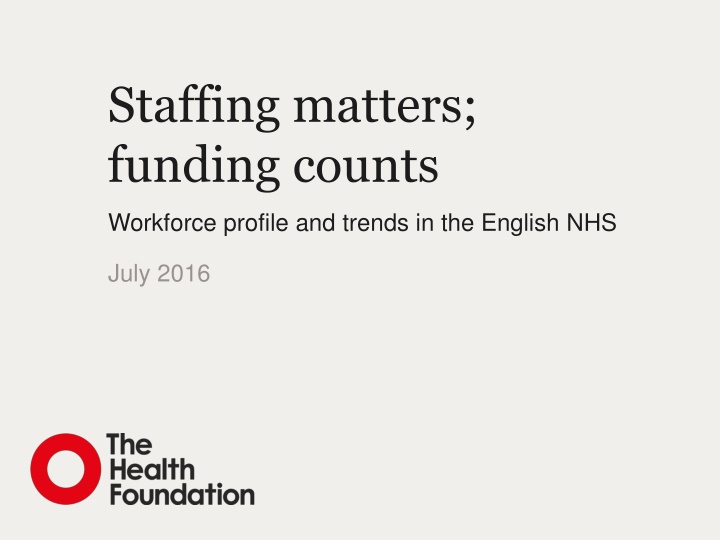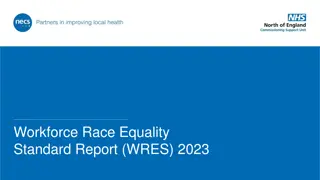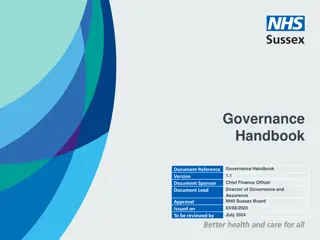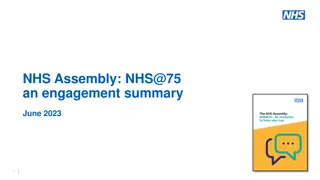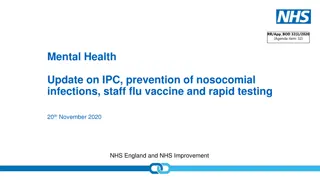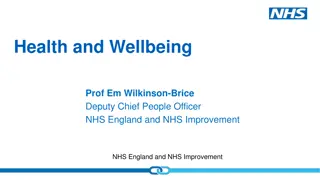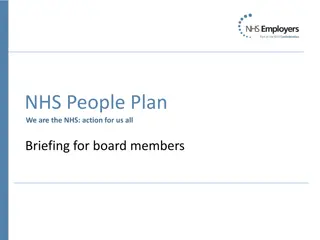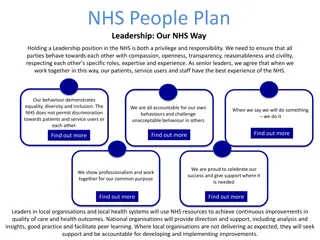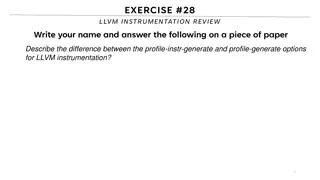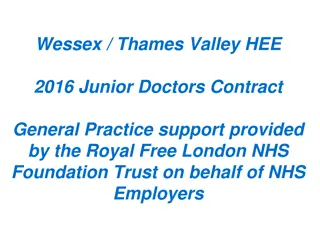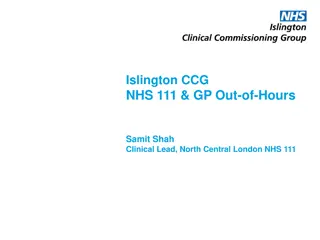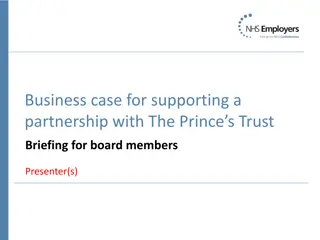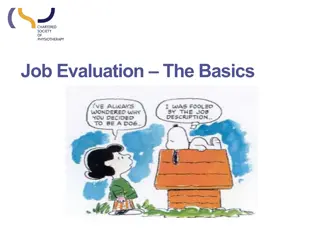Workforce Profile and Trends in the English NHS - July 2016
This report explores the staffing challenges and funding considerations impacting the English National Health Service (NHS) in July 2016. It delves into workforce policies, recent reports, and national changes in NHS workforce planning over the years. The document emphasizes the importance of addressing clinical staff shortages and optimizing workforce management for better patient care.
Download Presentation

Please find below an Image/Link to download the presentation.
The content on the website is provided AS IS for your information and personal use only. It may not be sold, licensed, or shared on other websites without obtaining consent from the author.If you encounter any issues during the download, it is possible that the publisher has removed the file from their server.
You are allowed to download the files provided on this website for personal or commercial use, subject to the condition that they are used lawfully. All files are the property of their respective owners.
The content on the website is provided AS IS for your information and personal use only. It may not be sold, licensed, or shared on other websites without obtaining consent from the author.
E N D
Presentation Transcript
Staffing matters; funding counts Workforce profile and trends in the English NHS July 2016
July 2016 Staffing matters; funding counts Figure 1: A Labour market framework for the health care workforce
July 2016 Staffing matters; funding counts Table 1: Recent workforce policy reports Organisation Report title Publication date Managing the supply of NHS clinical staff in England15 National Audit Office February 2016 Evidence from NHS Improvement on clinical staff shortages. A workforce analysis16 NHS Improvement February 2016 Operational productivity and performance in English NHS acute hospitals: Unwarranted Variations. An independent report for the Department of Health by Lord Carter of Coles17 Department of Health February 2016 NHS Pay review body: Twenty-Ninth Report18 NHS Pay review body March 2016 A perfect storm: an impossible climate for NHS providers12 The Health Foundation March 2016 Partial review of the Shortage Occupation List. Review of nursing19 Migration Advisory Committee March 2016 Fit for purpose? Workforce policy in the English NHS20 The Health Foundation March 2016 Managing the supply of NHS clinical staff in England. Fortieth Report of Session 2015 1621 Public Accounts Committee April 2016 Reshaping the workforce to deliver the care patients need22 Nuffield Trust May 2016
July 2016 Staffing matters; funding counts Table 2: National changes in NHS workforce planning in England, selected list, 2000 16 Year Change Year Change 2000 NHS Plan published NHS staffing growth targets published 2009 Medical Education England (MEE) and Professional Advisory Boards (PABs) established NHS HRH Plan published 2001 27 regional Workforce Development Confederations (WDC) established 2010 Department of Health (DH) publishes Developing the Healthcare Workforce proposing to create a new body which would supersede both MEE and the PABs. Health Education England (HEE) was to go live in April 2012 Primary Care Trusts (PCT) established NHS Modernisation Agency created NHS Workforce Review Team (WRT) established to produce national annual recommendations for planning for all of the main clinical staff groups National Workforce Development Board established 2002 Strategic Health Authorities (SHA) created 2010 DH contract a management consultancy to set up and run the Centre for Workforce Intelligence (CfWI), to be the national authority on workforce planning and development and the primary source of workforce intelligence National Workforce Review team closed down as a result; some staff and functions transferred to CfWI 2004 WDCs ended, merged with SHAs 2013 HEE becomes operational, absorbing MEE (a year later than initially planned); SHAs abolished NHS Employers established PCTs abolished; Clinical Commissioning Groups (CCGs) established NHS Institute for Innovation and Improvement closed 2005 Modernisation Agency replaced with NHS Institute for Innovation and Improvement 2016 CfWI closed down; some functions transferred to DH, and HEE NHS Improvement established (by merger of Monitor, Trust Development Agency and other bodies) 2006 Number of SHAs reduced from 28 to 10
July 2016 Staffing matters; funding counts Figure 2: Number of doctors/1,000 population in OECD countries, 2000 and 2013 (or nearest year)
July 2016 Staffing matters; funding counts Figure 3: Change in selected occupations in the English NHS 2004 14 (FTE)
July 2016 Staffing matters; funding counts Figure 4: Number of nurses employed in acute, general and elderly sectors, excluding bank and agency staff (FTE)
July 2016 Staffing matters; funding counts Figure 5: Staff:population ratios, 2004 14
July 2016 Staffing matters; funding counts Figure 6: Percentage of doctors who were foreign trained, 2013
July 2016 Staffing matters; funding counts Figure 7: Qualified nurses, midwives and health visitors (headcount) by age group, 2005 and 2014
July 2016 Staffing matters; funding counts Figure 8: Remuneration of hospital nurses, ratio to average wage, 2013 (or nearest year)
July 2016 Staffing matters; funding counts Figure 9: Remuneration of hospital nurses, US$000 purchasing power parity, 2013 (or nearest year)
July 2016 Staffing matters; funding counts Figure 10: Commencing enrolments of students for general nursing courses in Australia, 2002 14
July 2016 Staffing matters; funding counts Figure 11: International and UK sources as a % of total new admissions to the UK nursing register, 1990/91 2015/16 (initial registrations)
July 2016 Staffing matters; funding counts About us The Health Foundation is an independent charity committed to bringing about better health and health care for people in the UK. We connect what works on the ground with effective policymaking and vice versa. We shine a light on how to make successful change happen
July 2016 Staffing matters; funding counts Stay in touch Subscribe to our email newsletter Register for email alerts to be notified about our latest work Follow us on Twitter, Facebook, YouTube or LinkedIn @Healthfdn health.org.uk
